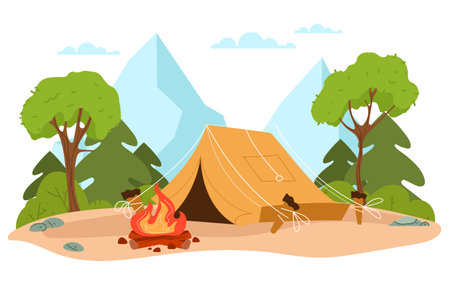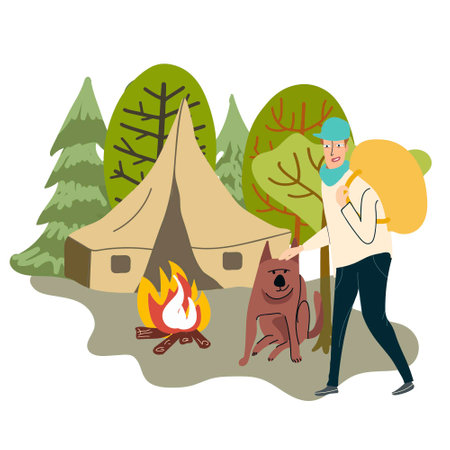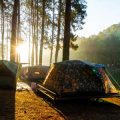1. Choosing the Right Campsite
Find a Safe Spot
Choosing where to set up camp is the first step to a safe and cozy winter experience. Look for a flat spot that’s not too close to tall, old trees with dead branches—falling limbs are dangerous, especially under heavy snow or wind. Try to avoid areas at the bottom of hills or near rivers since they can flood quickly if it rains or snows heavily.
Watch Out for Wind
Wind exposure can make your campsite colder than you expect. Find natural windbreaks like large rocks, thick bushes, or small hills. Set up your tent with the entrance facing away from the prevailing wind direction to keep it warmer inside.
Hazards to Avoid
| Hazard | How to Avoid |
|---|---|
| Falling Branches | Avoid camping under trees with large, dead, or overhanging limbs. |
| Flooding | Pick higher ground away from riverbanks and low-lying spots. |
| Strong Winds | Use natural barriers like rocks or hills for protection. |
Think About Privacy and Accessibility
It’s nice to have some space from other campers, but don’t go so far off that it’s hard to get help if you need it. Make sure your site isn’t too hidden and is easy to reach by foot or car in case of an emergency. Remember, a short walk to water and restrooms makes life easier during chilly nights.
2. Layering and Staying Warm
Why Layering Matters in Winter Camping
Staying warm is all about trapping your body heat while keeping out the cold. The right layers keep you comfortable, dry, and safe, even when temperatures drop below freezing.
The Three-Layer System
| Layer | Purpose | Best Materials |
|---|---|---|
| Base Layer | Wicks sweat away from your skin | Merino wool, synthetic blends (avoid cotton) |
| Middle Layer | Adds insulation to hold body heat | Fleece, down, insulated synthetics |
| Outer Layer (Shell) | Blocks wind, snow, and rain | Waterproof/breathable jackets or parkas |
How to Layer Properly
- Start with a snug base layer: This layer should fit close but not tight. Its main job is to pull moisture away from your skin.
- Add an insulating middle layer: Think of this as your warmth booster. Fleece is great for active movement, while down works well for sitting around camp.
- Top it off with a protective shell: Choose something that blocks wind and repels moisture. Make sure it has ventilation zippers if you plan to be active.
- Avoid cotton: It holds moisture and can make you colder.
Extra Tips for Keeping Warm at Camp
- Layer up before you get cold: It’s easier to stay warm than to get warm again.
- Wear a hat and gloves: Heat escapes quickly from your head and hands.
- Socks matter: Wool socks are best—bring an extra pair to swap out at night.
- Add insulation under you: Sleeping pads or foam mats keep the cold ground from stealing your heat.
- Tweak as needed: If you feel sweaty, unzip your shell or remove a layer before you get chilled.
This simple approach keeps you comfortable and safe while enjoying winter camping in the great outdoors.

3. Setting Up Shelter
How to Pitch a Sturdy Tent
Choose a flat spot, clear of snow and debris. Lay down a ground tarp for extra insulation. Anchor your tent with strong stakes or snow anchors, making sure all corners are tight and secure. Double-check the rainfly is properly fastened to keep warmth in and moisture out.
Key Steps to Pitching Your Tent
| Step | Action |
|---|---|
| 1. Pick Location | Find flat, sheltered ground away from falling branches or avalanche zones. |
| 2. Lay Ground Tarp | Spread a tarp under your tent for insulation and moisture protection. |
| 3. Stake Down Corners | Use sturdy stakes or snow anchors at each corner for stability. |
| 4. Attach Rainfly | Secure the rainfly tightly to trap heat and block wind-driven snow. |
Using Tarps Effectively
A tarp can add an extra barrier against wind, snow, and cold. Drape one over your tent as an additional roof, or set it up nearby as a covered cooking area. Make sure to angle the tarp so snow slides off easily, and use strong guylines to keep it steady during gusts.
Tarp Setup Ideas
- Tent Roof Cover: Extra insulation from above.
- Campsite Windbreak: Position on the windward side for added protection.
- Sheltered Cooking Area: Hang between trees for a dry meal spot.
Creating Windbreaks for Extra Protection
If there’s no natural cover, build your own windbreak using packed snow or stacked logs. Place it on the side facing the prevailing wind to shield your shelter and help hold in warmth. Even a small barrier can make a big difference on chilly nights.
4. Building a Safe Campfire
Essential Fire Safety Practices
Before starting any campfire, safety comes first. Always check local fire regulations and make sure fires are allowed in your area. Keep your campfire at least 15 feet away from tents, trees, and gear. Have water or snow and a shovel nearby to put out the fire quickly if needed.
Fire Safety Checklist
| Safety Tip | Why It Matters |
|---|---|
| Clear snow/ice down to bare ground | Prevents fire from spreading or melting unevenly |
| Build a windbreak with logs or rocks | Keeps sparks contained and fire burning steadily |
| Never leave fire unattended | Reduces risk of accidental wildfires |
| Keep fire small and controlled | Easier to manage and safer for all campers |
| Fully extinguish before sleeping or leaving site | Makes sure no embers can reignite overnight |
Fire Pit Construction in Winter Conditions
If there’s snow on the ground, pack it down tightly where you’ll build the pit. Dig down to soil if possible, or use a metal fire pan. Surround your pit with rocks to help contain heat and prevent it from spreading under the snow. If using wood, make sure it’s dry—wet or frozen wood is hard to light and burns inefficiently.
Simple Winter Fire Pit Steps:
- Packed Snow Base: Stomp down an area larger than your planned fire pit.
- Create a Shallow Pit: Dig out snow until you reach soil, or create a shallow bowl shape if ground is frozen.
- Add a Barrier: Place large rocks in a circle around your pit for insulation and wind protection.
- Lining: Lay down a sheet of aluminum foil or use a portable fire pan for extra safety and easy cleanup.
- Tinder Layer: Start with dry tinder, then add kindling, followed by larger logs once the fire is going strong.
Tips for Controlled & Efficient Fires in Snowy Weather
- Use smaller pieces of wood—these ignite faster and burn cleaner in cold air.
- Avoid building fires directly on thick ice; heat can melt through, creating hazards.
- Windy? Use tarps or your gear as windbreaks (but keep them well away from flames).
- If wood is damp, split it open—the inside may be drier and easier to burn.
- Keep backup fire starters handy (like waterproof matches or a lighter) since cold can drain batteries fast.
- Monitor the fire often; snowy conditions can put out flames quicker than you expect.
5. Managing Food and Water
Safe Storage and Preparation of Food
Winter camping means your food stays fresh longer, but it also brings its own challenges. To keep your meals safe and tasty:
- Store all food in airtight containers or bear-proof canisters.
- Keep food away from your sleeping area—at least 200 feet is best.
- Prepare meals before dark so you’re not fumbling with cold hands or limited light.
- Use insulated bags to keep perishables from freezing solid.
Melting Snow for Water
If running water isn’t available, snow can be your go-to source. Here’s a simple process:
| Step | Description |
|---|---|
| Collect Clean Snow | Gather only fresh, white snow—avoid any that looks dirty or has debris. |
| Melt Slowly | Add a little water to the pot first, then add snow gradually to avoid burning it. |
| Boil Thoroughly | Bring melted snow to a rolling boil for at least one minute to kill germs. |
Minimizing Wildlife Encounters
Wildlife is always curious about camp food, even in winter. Stay safe by following these tips:
- Avoid cooking near your tent.
- Hang food bags high in a tree if bear canisters aren’t available.
- Never leave scraps or trash behind—pack out everything you bring in.
Quick Tips Table
| Do | Don’t |
|---|---|
| Seal all food tightly | Leave snacks in your backpack overnight |
| Melt and boil snow for water | Eat snow directly (it cools you down) |
| Clean up after every meal | Bury or burn leftovers |
6. Nighttime Comfort and Safety
Creating Cozy Sleeping Arrangements
Staying warm at night is key to a great winter camping trip. Start by using an insulated sleeping pad—cold ground can sap your body heat fast. Pair it with a four-season sleeping bag, and layer up with thermal blankets or even a fleece liner if temperatures drop lower than expected. Wear dry, thermal base layers to bed and keep a beanie on your head to lock in warmth.
| Item | Why It Matters |
|---|---|
| Insulated Sleeping Pad | Prevents heat loss to the ground |
| Four-Season Sleeping Bag | Rated for low temperatures |
| Thermal Blanket/Liner | Adds extra warmth if needed |
| Dry Base Layers | Keeps you comfortable and warm all night |
| Beanie/Hat | Reduces body heat loss from your head |
Safe Lighting for the Night
Avoid tripping hazards and keep your camp safe by setting up reliable lighting. Battery-powered lanterns or LED string lights are great for inside your tent and around the campsite—they won’t give off fumes like traditional gas lanterns. Keep a headlamp handy for quick trips outside your tent during the night.
Lighting Tips:
- Hang a small lantern from the tent ceiling for hands-free light.
- Use solar-powered pathway lights to mark walkways or tent stakes.
- Keep backup batteries for all electronic lights.
- Avoid open flames inside tents—stick to battery-powered options for safety.
Staying Alert: Weather and Wildlife Checks
Winter weather can change quickly, so check local forecasts before bed and set up a weather radio nearby. If you’re in bear country or areas with active wildlife, store all food in bear-proof containers away from sleeping areas. Some campers set a phone alarm to check the weather conditions once during the night, especially if storms or heavy snowfall are expected.
| Strategy | Purpose |
|---|---|
| Weather Radio/Phone App Nearby | Stay updated on changing weather overnight |
| Bear-Proof Food Storage | Keeps wildlife away from camp |
| Midnight Alarm (if needed) | Check tent stability or snow buildup during storms |
Quick Safety Reminders:
- Keep emergency supplies like a whistle, first aid kit, and flashlight within arm’s reach.
- If camping solo, let someone know your location and check-in plan.
- Avoid storing wet gear in your sleeping area to prevent dampness and cold spots.
- If condensation forms inside the tent, crack open vents slightly to improve airflow without letting in too much cold air.


